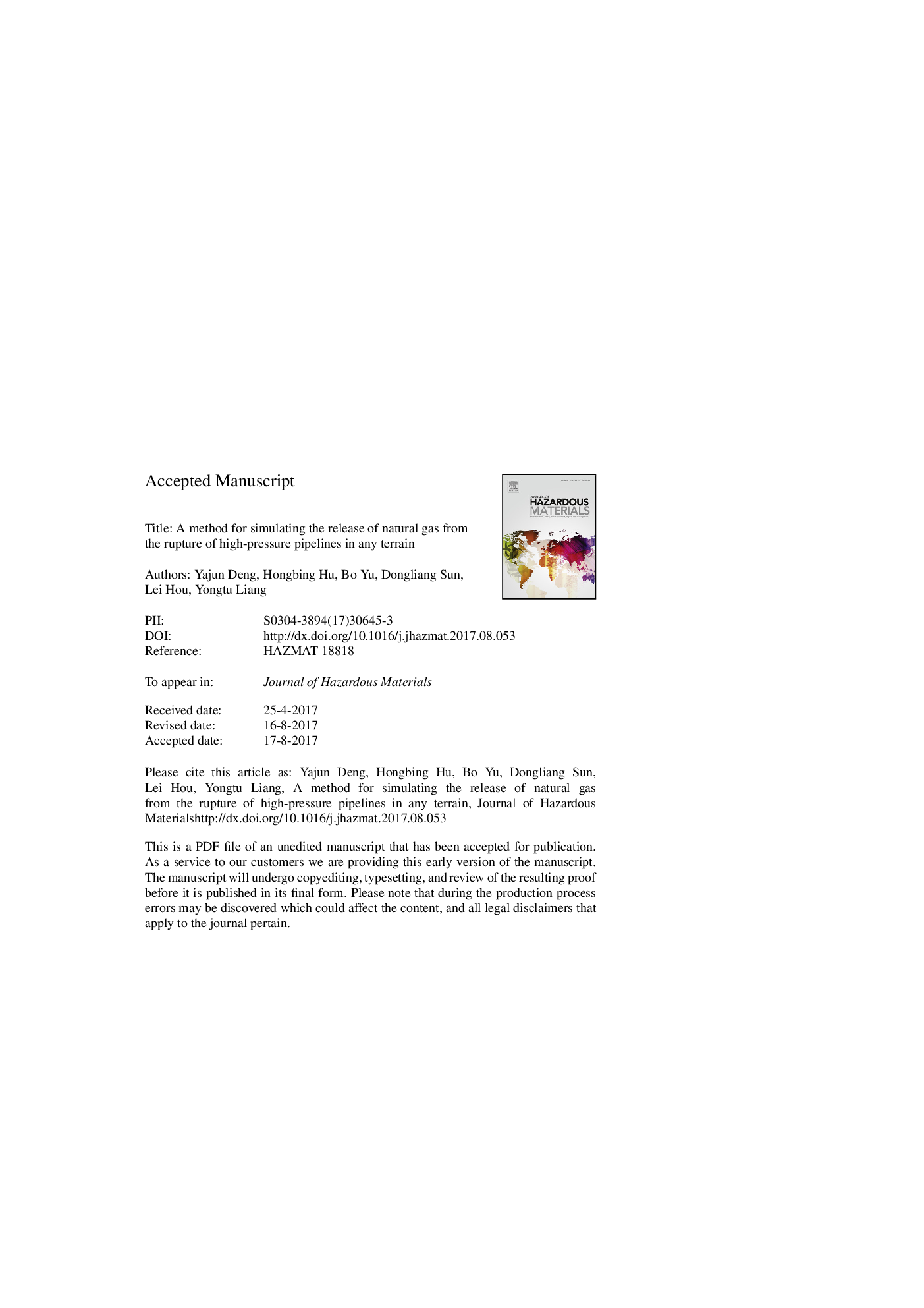| کد مقاله | کد نشریه | سال انتشار | مقاله انگلیسی | نسخه تمام متن |
|---|---|---|---|---|
| 4979099 | 1453021 | 2018 | 39 صفحه PDF | دانلود رایگان |
عنوان انگلیسی مقاله ISI
A method for simulating the release of natural gas from the rupture of high-pressure pipelines in any terrain
ترجمه فارسی عنوان
یک روش برای شبیه سازی انتشار گاز طبیعی از شکستن خطوط فشار بالا در هر زمین
دانلود مقاله + سفارش ترجمه
دانلود مقاله ISI انگلیسی
رایگان برای ایرانیان
کلمات کلیدی
شبیه سازی عددی، گاز طبیعی، پارگی خط لوله، سناریو پراکندگی، هر زمین،
ترجمه چکیده
پارگی خط لوله گاز با فشار بالا می تواند تهدید جدی برای زندگی و محیط زیست بشر باشد. در این تحقیق، یک روش برای شبیه سازی انتشار گاز طبیعی از پارگی لوله های تحت فشار در هر زمین ارائه شده است. فرایند گاز پس از شکستن یک خط لوله فشار بالا به سه مرحله تقسیم می شود: مرحله تخلیه، جت و مرحله پراکندگی. در ابتدا یک مدل تخلیه برای محاسبه میزان آزاد شدن خروجی از سوراخ ایجاد شده است. در مرحله دوم، یک مدل بهبودی جت برای به دست آوردن پارامترهای شبه منبع پیشنهاد شده است. سوم، یک روش سریع مدل سازی قابل اجرا برای هر زمین است. در نهایت، براساس این سه مرحله، یک مدل پراکندگی، که می تواند هر زمین را به حساب آورد، ایجاد شده است. سپس، سناریوهای پراکندگی گاز آزاد شده در چهار حوزه مختلف مورد بررسی قرار می گیرند. علاوه بر این، اثرات خط لوله، قطر لوله، سرعت باد و غلظت سولفید هیدروژن بر روی سناریوی پراکندگی در زمین واقعی، به طور سیستماتیک تجزیه و تحلیل می شود. این نتایج راهنمایی های قابل توجهی برای ارزیابی خطر و برنامه ریزی احتمالی یک خط لوله گاز طبیعی شکسته ارائه می دهد.
موضوعات مرتبط
مهندسی و علوم پایه
مهندسی شیمی
بهداشت و امنیت شیمی
چکیده انگلیسی
The rupture of a high-pressure natural gas pipeline can pose a serious threat to human life and environment. In this research, a method has been proposed to simulate the release of natural gas from the rupture of high-pressure pipelines in any terrain. The process of gas releases from the rupture of a high-pressure pipeline is divided into three stages, namely the discharge, jet, and dispersion stages. Firstly, a discharge model is established to calculate the release rate of the orifice. Secondly, an improved jet model is proposed to obtain the parameters of the pseudo source. Thirdly, a fast-modeling method applicable to any terrain is introduced. Finally, based upon these three steps, a dispersion model, which can take any terrain into account, is established. Then, the dispersion scenarios of released gas in four different terrains are studied. Moreover, the effects of pipeline pressure, pipeline diameter, wind speed and concentration of hydrogen sulfide on the dispersion scenario in real terrain are systematically analyzed. The results provide significant guidance for risk assessment and contingency planning of a ruptured natural gas pipeline.
ناشر
Database: Elsevier - ScienceDirect (ساینس دایرکت)
Journal: Journal of Hazardous Materials - Volume 342, 15 January 2018, Pages 418-428
Journal: Journal of Hazardous Materials - Volume 342, 15 January 2018, Pages 418-428
نویسندگان
Yajun Deng, Hongbing Hu, Bo Yu, Dongliang Sun, Lei Hou, Yongtu Liang,
